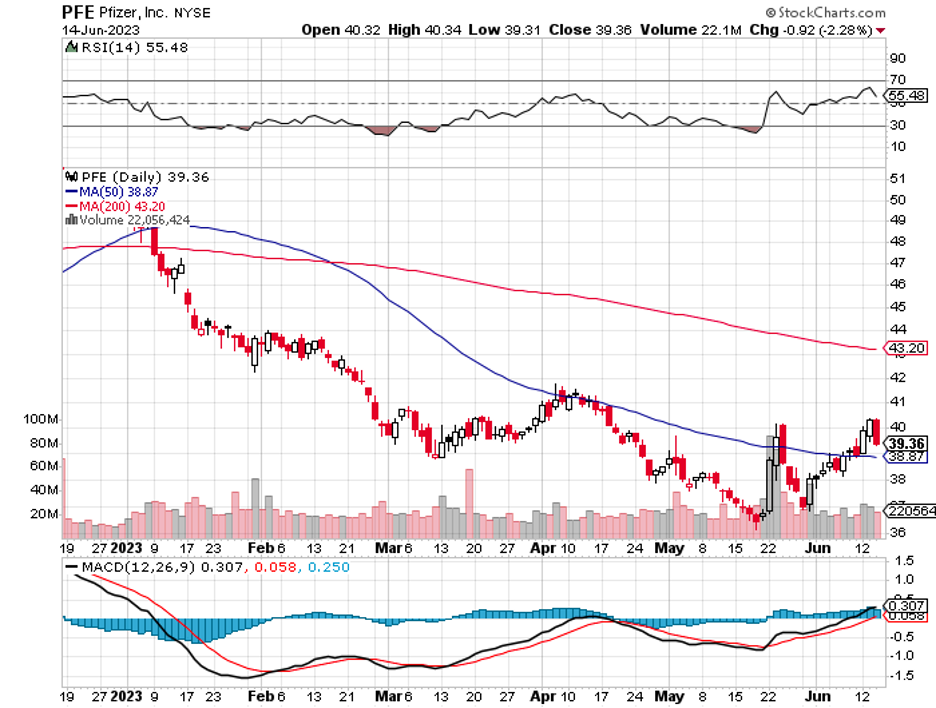Ever tuned into "The Price is Right?" That's not just a television game show entertaining millions across the nation. It's also an unwritten rule in the world of investment.
Buying at the right price sets the average apart from the pros; it's the secret sauce that tips the scales in favor of handsome returns.
Bargain hunting in the stock market is not unlike fishing in a lake brimming with opportunities. Yet, not every catch is worthy.
Some are just slippery eels, deceiving with their alluring glow. But once in a while, you reel in the big ones, the blue whales of opportunities.
In the biotechnology and healthcare world, only a handful of names offer promising opportunities cloaked in bargain price tags, waiting to be embraced for the long haul.
One of them is Pfizer (PFE).
The past year was a blockbuster for Pfizer, all thanks to its sizzling COVID-19 vaccine that not just saved lives but also sent its sales soaring to an enviable $100 billion.
Yet, ironically, investors seem to be catching a cold, given the bearish sentiment surrounding Pfizer lately.
Pfizer’s stock has experienced a bruising blow, slumping by roughly 25% since 2023 started. The stock is precariously hovering around its 52-week low, with its low price-to-earnings multiple under 8, mirroring the market's deep skepticism.
At almost 11.7 times forward earnings, the valuation sits comfortably below the towering S&P 500, the robust healthcare sector, and the buzzing pharmaceutical industry.
So, what's putting the brakes on Pfizer's race?
The pharmaceutical behemoth is grappling with dwindling revenues and profits courtesy of diminishing COVID-19 sales. Patent expiration is another boogeyman looming on the horizon.
Pfizer's top hitters, namely Eliquis, Ibrance, Vyndaqel, Xeljanz, and Xtandi, are on the cusp of losing their patent shield. But Pfizer isn't sitting idle, staring at the cliff.
The company is all set to face this challenge, with acquisitions headlining its battle strategy. Over the past years, Pfizer has added multiple feathers to its cap, including Biohaven Pharmaceuticals, Arena Pharmaceuticals, Global Blood Therapeutics, ReViral, and, most recently, the $43 billion acquisition of biotech Seagen.
Pfizer's eyes are firmly on the oncology prize, and its calculated acquisitions could set it up for a long-term growth trajectory, mitigating the impact of the COVID slump and the upcoming patent crisis.
While 2023 might look bleak for Pfizer's COVID-19 vaccine, Comirnaty, the company is hopeful for a sunny spell in 2025 with the proposed launch of its combo COVID-flu vaccine. In addition, its COVID-19 antiviral therapy, Paxlovid, is expected to make a strong comeback next year.
Admittedly, the patent expiry of key products is a concern, but Pfizer's new product launches up to mid-2024 are predicted to compensate for these losses, promising robust annual revenues by 2030.
The business deals in the pipeline are also projected to bring in an additional $25 billion in annual revenue by 2030.
On top of these, Pfizer's financial health is hardy, thanks to a couple of years of potent free cash flow. As of April 2, it boasted a hefty $20 billion in cash and short-term investments. The financial muscle ensures Pfizer can continue its acquisition spree if needed.
More importantly, Pfizer continues to shower its shareholders with an enticing dividend yield of over 4.1%.
As Pfizer forges ahead on its quest for growth and diversification, now might be the perfect time to hitch a ride, particularly considering its bargain price and a sizeable safety margin for investors.
Pfizer is a hidden gem in the current landscape, with its undervalued shares and a strategy bolstered by a series of strategic acquisitions.
As the acquisitions simmer down, expect a redirection of investment returns towards shareholders, potentially lifting the stock's sentiment and price. Meanwhile, the solid dividend growth will keep investors anchored in a fluctuating FED environment.
Overall, Pfizer presents a captivating prospect for long-term investors looking to reel in the big fish. I suggest you take advantage of the dip.



